In Ramona Gardens, an easing of long-simmering tensions
A few residents and a Latino gang worker who grew up there joined to improve race relations in the Boyle Heights housing project long known for hostility to blacks.
- Share via
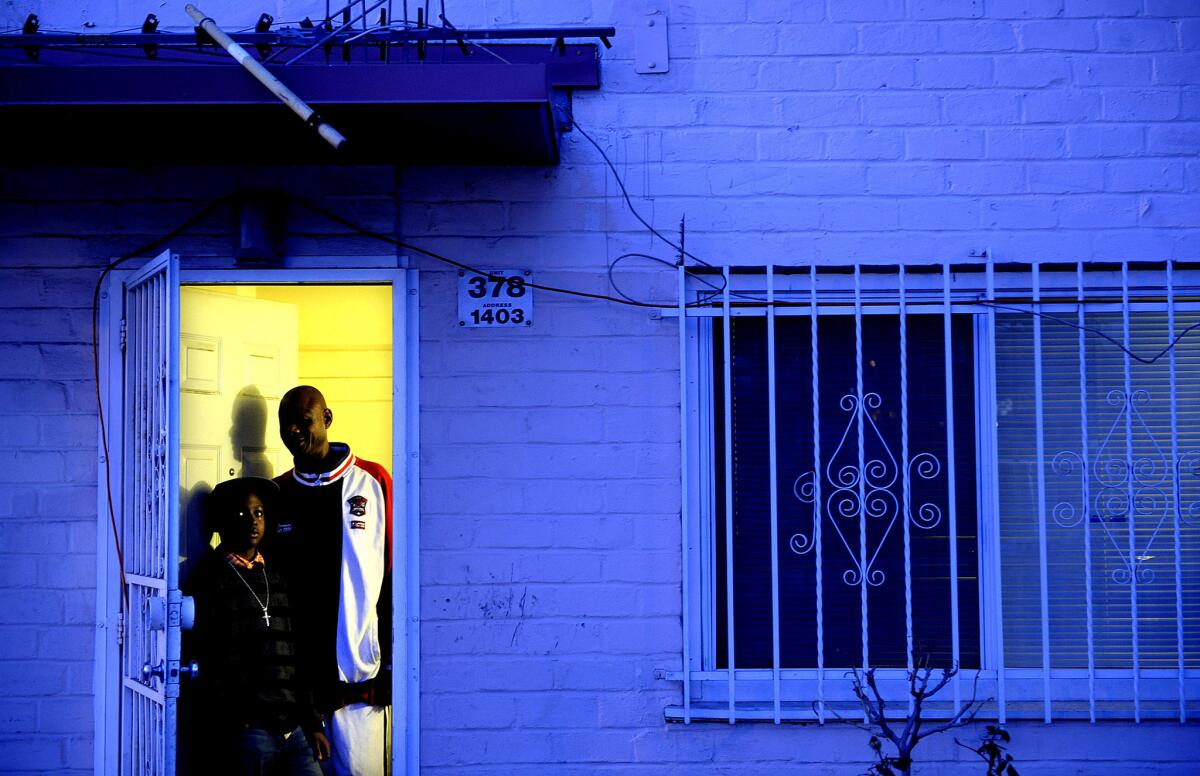
They were eating dinner in their Ramona Gardens living room when the rock crashed through the window like a meteorite.
Jeff Littrel and his little boy hadn't been in their home more than a few days. Peering through the torn screen and shattered glass, they saw the shadows of young men in the dark.
Three years later, father and son are sitting in the same room, in the same Boyle Heights housing project. An old episode of "Fat Albert" plays on the TV. Malik, a bright 11-year-old with a sunny demeanor, screws up his face and asks his father: "Do you still have the rock?"
"I still have the rock," the 49-year-old restaurant cook replies. "Just to remind me where I'm at. So I'll never be slipping."
For nearly two decades, black families like the Littrels were but a rumor in the project. Their absence, in fact, had become a defining characteristic of "R.G.," a Latino neighborhood built at the bottom of a hill and bounded by railroad tracks, factories and the San Bernardino Freeway.
And Big Hazard, the gang that has claimed Ramona Gardens since the 1940s, intended to keep it that way.
When the Housing Authority of the City of Los Angeles started moving black families back in about four years ago, George Sarabia, a gang intervention worker who spent his youth in Big Hazard, was ready for trouble.
"People were getting guns pulled on them," the 41-year-old said. "They were being told to get -- out of here."
Sarabia had visions of black families being terrorized, the FBI swooping in to investigate hate crimes, a wide net being cast -- and much of what had been gained by the hard-luck neighborhood and its mostly decent residents being washed away.
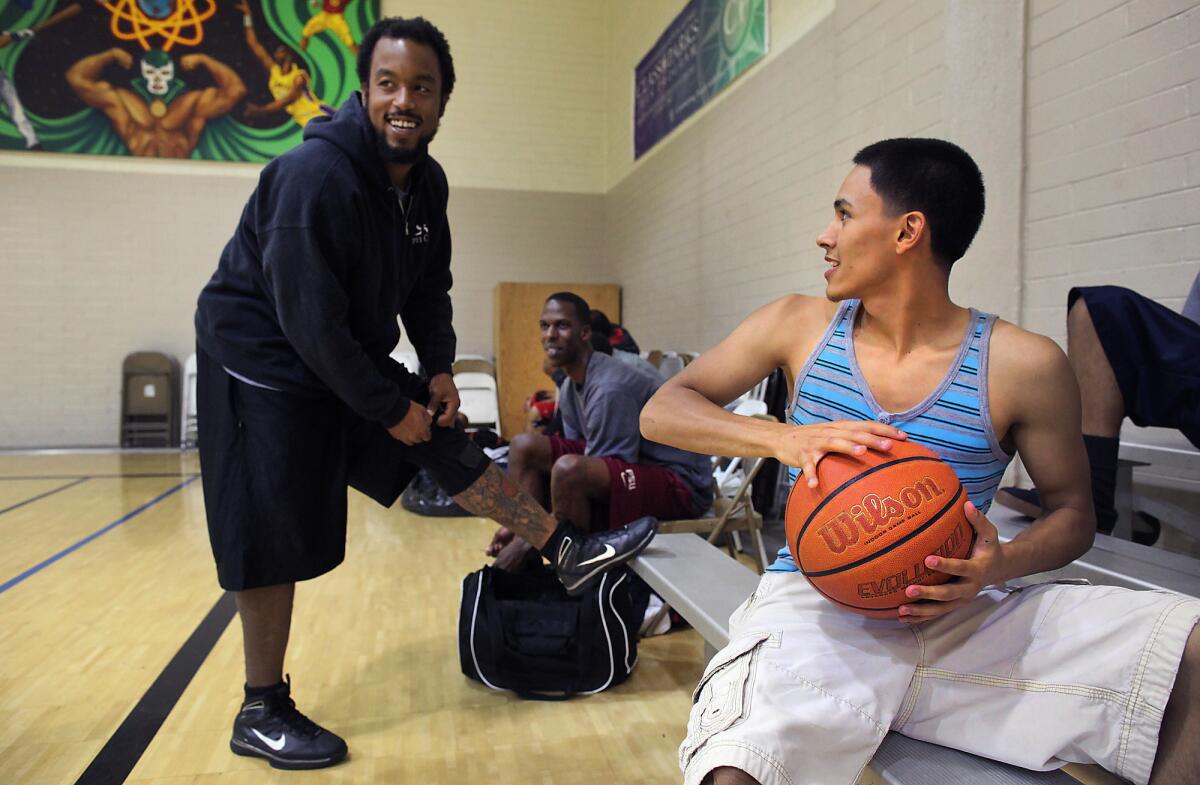
C.J. Johnson, left, prepares to play in a basketball tournament. Johnson's family is one of about 16 black families living in Ramona Gardens. (Brian van der Brug / Los Angeles Times) More photos
He approached some Big Hazard veterans about the racial issue.
"Some just walked away. Some guys were like, 'I don't know what to tell you.' Nobody wanted to vouch for me or get involved on any level," he said. "But there was still hope because nobody told me no."
Finally, Sarabia said, he found someone with juice in the gang who told him to go ahead and help however he could. Sarabia said he asked only for one favor: "I said, 'If I'm in danger, just tell me. Can you do that?'"

The explosion ripped through the pantry of a Ramona Gardens apartment. When the black couple and their seven children ran outside, they realized that another black family across the street had been attacked minutes earlier.
It was late August, 20 years ago.
Seven black families lived in the housing project back then. But they quickly began to leave after the firebombings. A Los Angeles councilman denied that the attacks were racial, blaming them on teenage gangsters "loaded" on PCP.
People in the neighborhood knew better. Most kept quiet. One who didn't was an elderly black woman remembered by residents as Mama Meyers. When TV cameras showed up at the projects, she said the families were targeted because of the color of their skin.
Then a 21-year-old gang member, Sarabia sidled up to Mama Meyers and gently tried to get her to stop talking. The next day she called the skinny gang member over to her wheelchair and smacked Sarabia with her cane.
"She said, 'Why wouldn't you let me tell the truth? What's wrong with you?' " he recalled. "She was yelling at me. She was saying, 'It was racial. You think these families were run out because they were Mexican?'"
Los Angeles was a different place back then. More than 1,000 people were killed in the city a year, mostly in gang violence. Though South Los Angeles got most of the attention, the 15.2 square miles in the Eastside patrolled by the LAPD's Hollenbeck officers actually had the largest concentration of gangs -- more than 30.
People were getting guns pulled on them. They were being told to get -- out of here."— George Sarabia, gang intervention worker
Big Hazard had some of the deepest connections to the Mexican Mafia prison gang, which heavily influenced Latino gangs, including directing attacks on blacks.
To officers, Ramona Gardens had always seemed particularly clannish. Many of the families had been there for more than a generation, and some had ties to Big Hazard.
Some residents remembered LAPD officers doing foot beats long ago in the projects, a warren of peach bungalows spread over 32 acres of vast lawns peppered with flower beds and a playground. But by the 1980s, the relationship between law enforcement and the neighborhood had become fraught and, at times, dangerous.
Police officers said it wasn't unusual for them to be shot at if they ventured into Ramona Gardens. Some officer-involved shootings led to tense standoffs. Almost all involved gang members, but some residents said that in its zeal to go after Big Hazard, the LAPD often cast a wider net that led to abuses.
And then there were the old issues of race. Sarabia worried about the black families moving in, but an unwanted fear crept within him.
"I was scared for the families," he said. "But I also got a little paranoid. I thought, 'What if they do start taking over?' Even I went through that. And I should have known better."

Jeff Littrel had applied for public housing before Malik was born, knowing that he would need to provide a stable home after years as a traveling musician. In 2009, when he got the letter from the housing authority telling him there was a unit available in Ramona Gardens, he didn't think twice.
"I came to check it out. I didn't have much of a choice. I was living in a studio over a boat repair shop," he said. "It didn't matter where I was going, I was going to say yes."
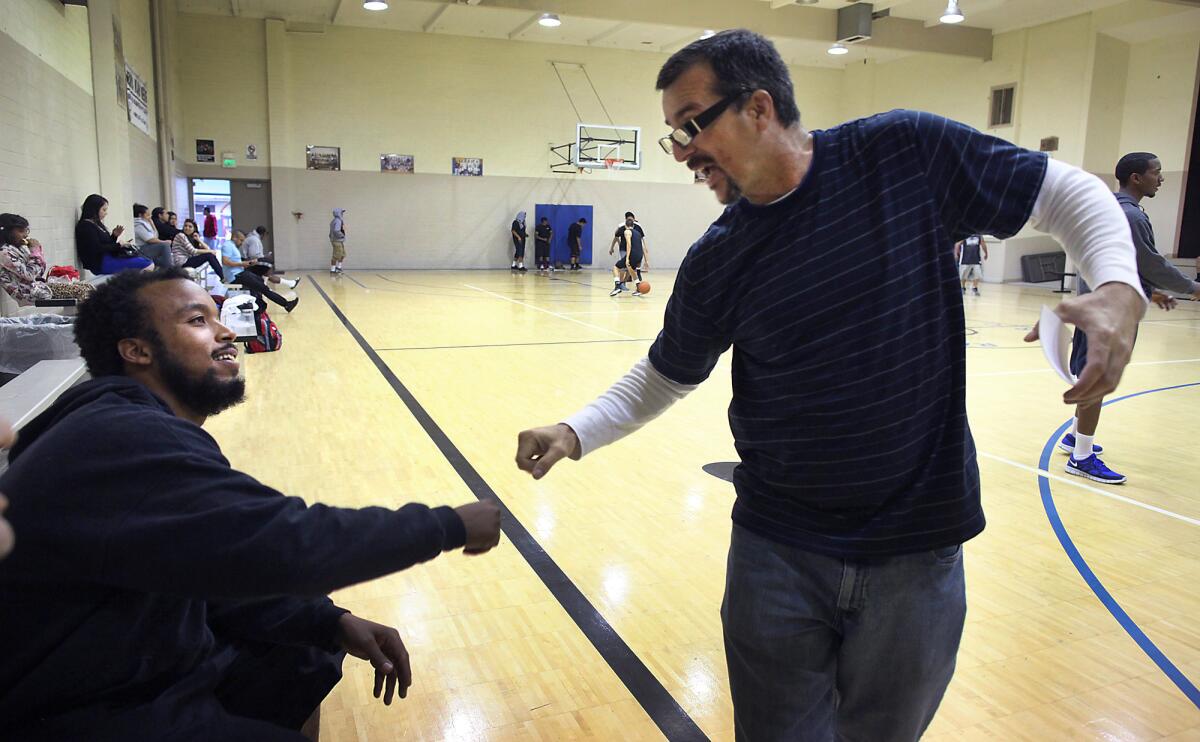
C.J. Johnson, left, fist bumps gang intervention worker George Sarabia inside the gymnasium. "C.J. opened a door," Sarabia said. "I told him, 'You know what I want to do. I can't do it without you. We've got to break that barrier.'" (Brian van der Brug / Los Angeles Times) More photos
The housing project didn't look ominous. But a few days after the rock incident, he stepped into the heart of Ramona Gardens -- the gym.
"One of the older cats pulled me to the side and asked me where I was from," he recalled. "He let me know he felt it was strange I just walked into the gym. He said, 'We can't go to Nickerson Gardens, to your gym, and just play basketball.' "
He couldn't tell whether it was a threat, a warning, or both.
An easy, soft-spoken man by nature, Littrel decided to be as respectful as possible, even when young gang members told him that it wasn't his neighborhood.
Over the years, Littrel realized that the vast majority of people in the neighborhood were generous and kind. Sometimes he would share barbecue he cooked in his frontyard. He mostly stayed close to home, but was a fixture at his son's baseball and basketball games, and even refereed neighborhood soccer games. Malik, like most boys, had a freer rein of the neighborhood, and became his father's saving grace.
The boy was not only a good student, but an affable child who quickly made friends. The mantelpiece of their apartment is crowned with 10 trophies Malik had won, mostly for playing sports in Ramona Gardens. The tallest, though, proclaimed him spelling bee champ for the third and fourth grade for all of the city's housing projects.
If the years after the rock incident were largely peaceful, Littrel said, Malik was a major reason.
"He's got more love than me around here," he said proudly, gazing at his boy, who returned his smile. "I can pretty much go wherever, but because of him. They know I'm Malik's daddy!"
Once in a while, Malik said, someone will say something insulting. Like his dad, he tries to be Zen.
"If they try to mess with you," he said, "you just play it cool."

When Sarabia was a boy, he couldn't wait to dress like his older brothers in the gang. To comb his hair, to talk and walk like them. Los Angeles was a shooting gallery then if you were in a gang, but Sarabia didn't sweat that much.
On the day the Gulf War started, he was standing outside a grocery store in Ramona Gardens where he worked, arguing with a homeboy, when rivals drove by and gunned both of them down. Another friend dragged them into his car and sped to nearby Los Angeles County-USC Medical Center.
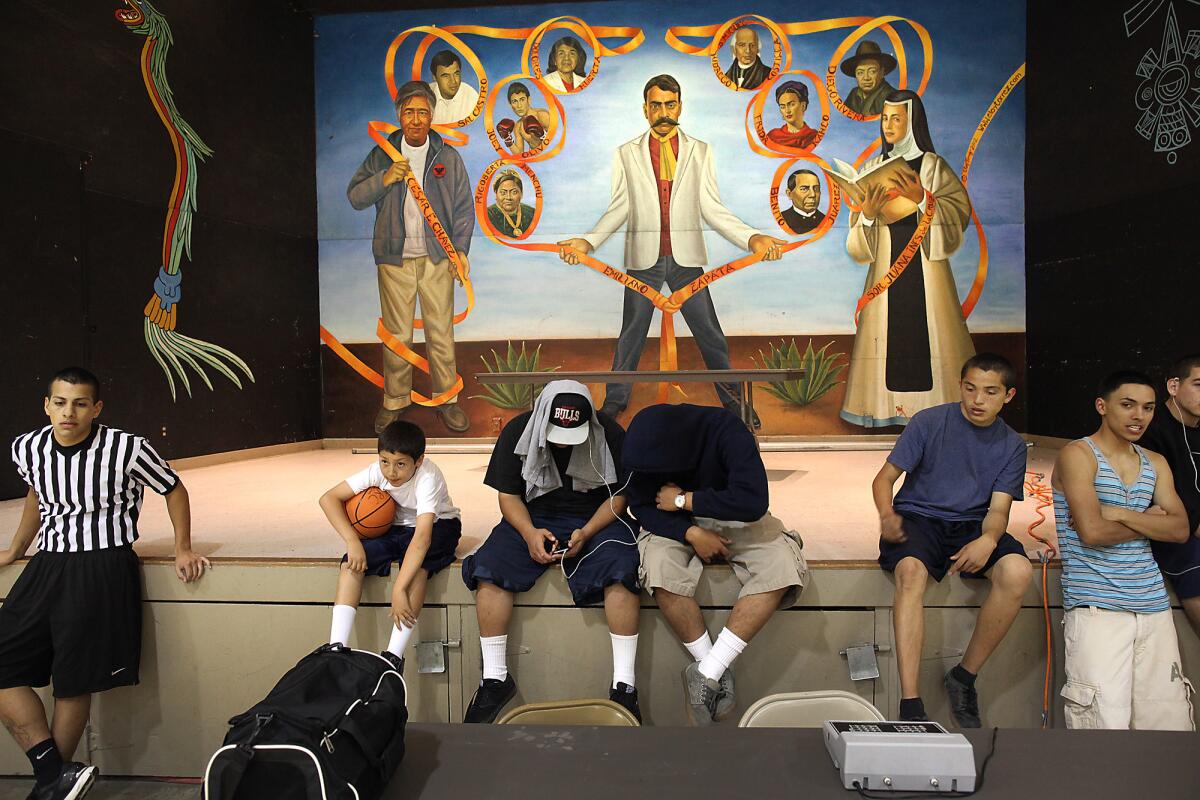
Spectators sit on the stage inside the gym between games. Last year, during the NBA finals, a more historic championship game was about to take place in Ramona Gardens: the first one played between two mostly black teams. (Brian van der Brug / Los Angeles Times) More photos
Sarabia said he was being wheeled into surgery when he looked up and saw the face of a black doctor. Rather than feel gratitude, he uttered a curse in his mind and thought: "I'm going to die at the hands of a black man."
The doctor told him he was going to be OK. One of the bullets just missed his heart and he had a collapsed lung, but he would heal.
Two years later, though, one of Sarabia's younger brothers was killed by rival gang members. He started to reassess his life.
But no one, and no place, changes that fast.
By the time black families like the Littrels started moving back in, Sarabia was working for Legacy L.A., a nonprofit devoted to advocating for Ramona Gardens. He still didn't trust cops, but he had come to trust at least one: Sgt. Ray Marquez, who ran the LAPD gang unit responsible for Ramona Gardens. Like him, Marquez was a son of Boyle Heights. He was no-nonsense but fair, looking to build bonds in the neighborhood, not just crack down.
At the time, black people were getting beaten up; guns and slurs were being aimed at them. Sarabia and Marquez discussed setting up a meeting with some of the gang's shot-callers, figuring they could regulate the behavior of others.
A larger meeting in the gym dealt with the issue of hate crimes. Some gang members joined the meeting, listening quietly from the bleachers.
The gym is the heart of Ramona Gardens -- and the change coming to the project.
For several years, Sarabia has run basketball tournaments there. About three years ago, a young black resident named C.J. Johnson walked in. Johnson had moved to the projects in 2009 with his Mexican American girlfriend, just before the birth of their son.
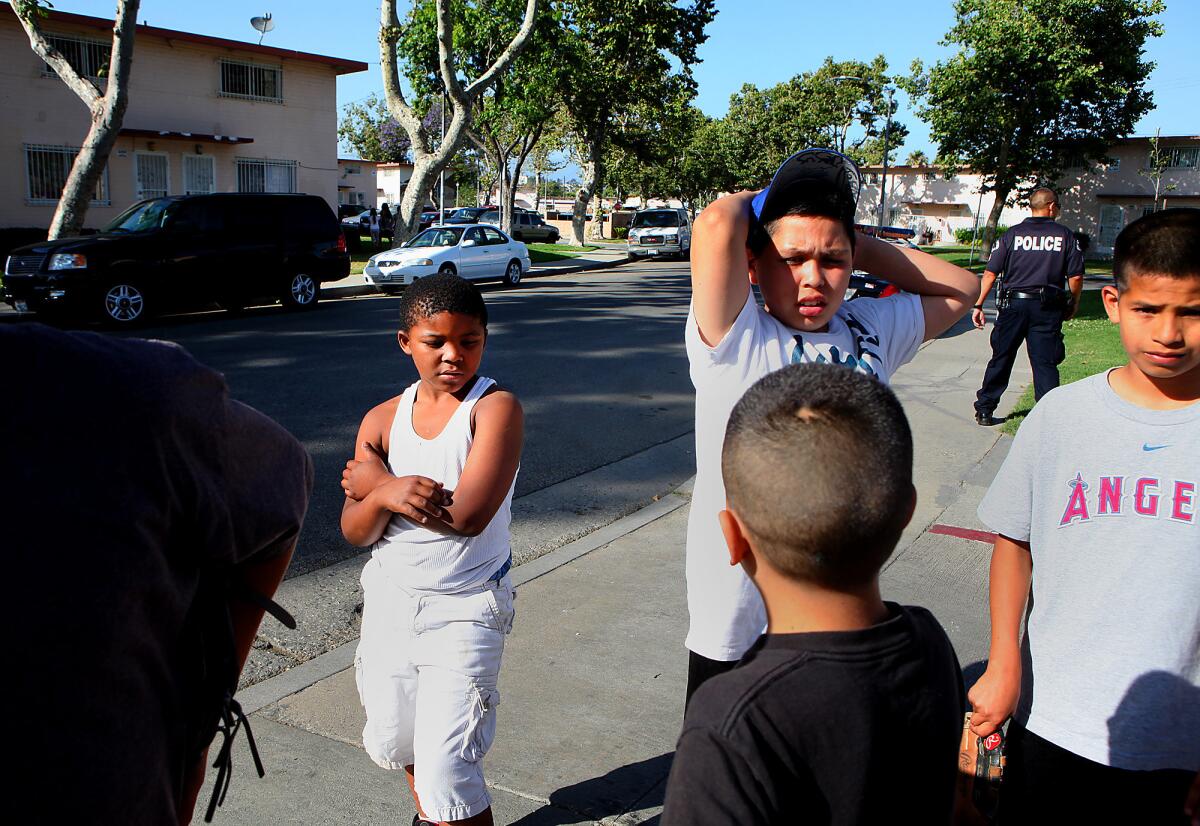
Children mill around outside the gym. (Brian van der Brug / Los Angeles Times) More photos
His mother had warned him about moving into the neighborhood. But he was undeterred, telling her his faith would protect him.
Sarabia saw an opportunity in Johnson, 31, who expressed interest in participating in the tournaments. Sarabia was impressed by Johnson's good nature and willingness to show up at the gym with his toddler son to shoot hoops with little evident fear or bravado. Sarabia asked him to bring a team of black players to Ramona Gardens.
"C.J. opened a door," said Sarabia, who is thin and bespectacled, with a reedy voice that's reminiscent of a Mexican American Joe Pesci. "I told him, 'You know what I want to do. I can't do it without you. We've got to break that barrier.'"
At least one black player would get a gun pulled on him in the games to come, but they kept coming and the games kept happening. Last year, during the NBA finals, a more historic championship game was about to take place in Ramona Gardens: the first one played between two mostly black teams.
Sarabia called it "history in the making!" Before the tipoff, he huddled the two teams in mid-court and thanked them for being there, telling them it was his honor to referee the game.

In some ways, the progress in Ramona Gardens is the tenuous but undeniable story of Los Angeles.
In some ways, the progress in Ramona Gardens is the tenuous but undeniable story of Los Angeles.
The City of Angels is far less lethal than it once was. People don't seem as tolerant of overt gang behavior as they used to be. Public housing projects like Ramona Gardens are also decked with video cameras now, and injunctions -- though controversial -- have made it harder for gangs to predominate as they used to.
For Ramona Gardens, there has been no neat happy ending, and there may never be. But hardly anyone denies that things are much better than they were 20 years ago. Or even four years ago.
Today, about 16 black families live in Ramona Gardens, a dip from about 25 that lived there a year or two ago, but much higher than the zero that lived there for years. It's just one sign of progress, along with a popular Saturday swap meet and the sight of Latino and black children playing together.
The white-knuckle tension that used to define the relationship between much of the neighborhood and the LAPD has eased dramatically. During a Christmas toy giveaway in December, an LAPD helicopter swooped low for show, lighting up the neighborhood. Just a few years ago, this would have been seen by more than a few residents as an act of intimidation. On this night, cheers rose in the chilly air.
Littrel stopped by the festivities. He talked to a few residents, who recognized him as Malik's father. It's unlikely many knew that a month before, someone wrote a message for him on the dust that had accumulated on his car: "Move out...." it said, using a racial slur.
But in truth, he said, he considered himself luckier than other black families. Malik is going to a school for children who want to be on track for college. He got A's on a recent report card. Ramona Gardens is his home.
A few of the Big Hazard veterans, his dad said, even look out for him.
And those trophies on the mantelpiece? They have Malik's name. But they're not just Malik's, he said. Take the one for the spelling bee.
"He didn't win it for himself," Littrel said. "He won for Ramona Gardens."
Column One: More great reads from the Los Angeles Times
For gunsmith, a full-bore interest and a high gauge of expertise
Sign up for Essential California
The most important California stories and recommendations in your inbox every morning.
You may occasionally receive promotional content from the Los Angeles Times.








